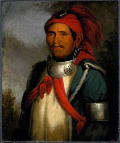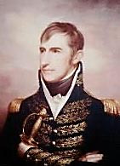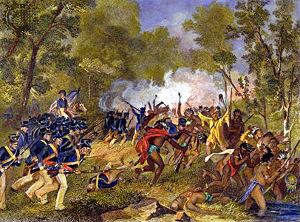The Battle of Tippecanoe
The Battle of Tippecanoe pitted Americans and Native Americans in a struggle for supremacy in what is now Indiana in the early 19th Century. Americans and Native Americans had come into contact and conflict with one another for many years, first on the Eastern Seaboard and then in the Old Northwest. It was in this particular part of what is now the United States that some of the fiercest fighting took place. The Treaty of Paris that ended the Revolutionary War had handed control of this area over to the Americans, but British forces did not abandon their forts. British troops also actively supported Native Americans in their efforts to hold on to their lands in the face of continued American settlement. One particular fierce confrontation came in 1794, at the Battle of Fallen Timbers. American forces led by "Mad" Anthony Wayne scored a decisive defeat of a Native American confederacy led by Miami chief Little Turtle, and Shawnee Blue Jacket. Also present at that battle was a future Shawnee leader, Tecumseh (above). Wayne followed his military victory with several months of intense negotiations that resulted in the Treaty of Greenville, the terms of which required tribal leaders to give up their lands to American settlers and move to the northwestern part of what is now Ohio. This was neither the first nor the last time that Native Americans agreed or were forced to leave lands on which they had been living for many years. Starting in 1808, Tecumseh and his younger brother, Tenskwatawa, began a drive to stop the sale of Native American lands to American settlers, either for money or in trade. The movement wasn't entirely successful because the very next year, the Treaty of Fort Wayne resulted in 3 million acres of land changing hands. The location for the battle, which took place on Nov. 7, 1811, was at the confluence of the Tippecanoe River and the Wabash River, outside the Native American settlement of Prophetstown, which was a headquarters for the burgeoning Native American confederacy. 
Leading the Native American confederacy in the battle was Tenskwatawa. Tenskwatawa had gained quite a reputation for speaking prophecies, so much so that he came to be called The Prophet. Tecumseh was not in the defending force because he had embarked on a mission to the South in order to recruit more Native Americans to what he hoped would be a north-to-south confederacy. He had left express instructions that his brother was to avoid any fighting until Tecumseh returned, hopefully with more armed warriors. 
Indiana Territory Gov. William Henry Harrison had a contingent of 1,100 men (including Indiana's famed Yellow Jackets and a contingent of Indiana Rangers), so it was difficult to hide their presence as they camped along Burnett Creek, to the west of Prophetstown. They had an embankment to their east, on the other side of which were the Native American forces, so Harrison did not issue the usual order of creating temporary works around the encampment. One of the things that Tenskwatawa, The Prophet, prophesied before the battle was that his fellow warriors could not be Harrison and many others in American declared the Battle of Tippecanoe a victory, although Harrison lost more men, 188 (62 killed), than Tenskwatawa, 130 (50 killed), did. Harrison certainly cashed in on his sudden fame, riding it all the way to the White House when he was elected President in 1840. One thing that the battle did do was put a dent in The Prophet's credibility. Another result was that Tecumseh had to work even harder to convince more Native Americans to join his cause. |
|
Social Studies for Kids
copyright 2002–2025
David White



 hurt by white men's bullets. Things started with a peace conference, which both sides approached warily. Full of confidence, the Native Americans attacked, first by sending an elite force in an attempt to kill Harrison outright and then by launching a dawn attack. (Some reports say that The Prophet ordered the attack; other sources say that he did so only after some of his warriors started the fighting.) They attacked two different times, each time surrounding Harrison's force. Both times, the Americans stood their ground, at one point fixing bayonets and charging to repulse an attack. In the end, Harrison's superiority in numbers and firepower were enough. Tenskwatawa ordered a retreat and then an evacuation of Prophetstown. Harrison's men spent a day preparing for another attack, then advanced on the town. Seeing it empty, they burned it to the ground. Just before doing so, then took possession of thousands of bushels of corn and beans that the residents had left behind.
hurt by white men's bullets. Things started with a peace conference, which both sides approached warily. Full of confidence, the Native Americans attacked, first by sending an elite force in an attempt to kill Harrison outright and then by launching a dawn attack. (Some reports say that The Prophet ordered the attack; other sources say that he did so only after some of his warriors started the fighting.) They attacked two different times, each time surrounding Harrison's force. Both times, the Americans stood their ground, at one point fixing bayonets and charging to repulse an attack. In the end, Harrison's superiority in numbers and firepower were enough. Tenskwatawa ordered a retreat and then an evacuation of Prophetstown. Harrison's men spent a day preparing for another attack, then advanced on the town. Seeing it empty, they burned it to the ground. Just before doing so, then took possession of thousands of bushels of corn and beans that the residents had left behind.
